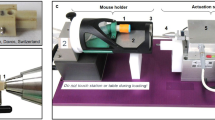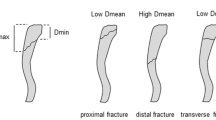Abstract
Fracture repair is influenced by the mechanical environment, particularly when cyclic loads are applied across the fracture site. However, the specific mechanical loading parameters that accelerate fracture healing are unknown. Intact bone adaptation studies show enhanced bone formation with pauses inserted between loading cycles. We hypothesized pause-inserted noninvasive external loading to mouse tibial fractures would lead to accelerated healing. Eighty mice underwent tibial osteotomies with intramedullary stabilization and were divided into four loading protocol groups: (1) repetitive loading (100 cycles, 1 Hz); (2) pause/time-equivalent (10 cycles, 0.1 Hz); (3) pause/cycle-equivalent (100 cycles, 0.1 Hz); and (4) no load control. Loading was applied daily for 2 weeks. Healing was assessed using histology, biomechanical bending tests, and microcomputed tomography. The pause-inserted, cycle-equivalent group had a greater percentage of osteoid present in the callus cross-sectional area compared with no-load controls, indicating more advanced early healing. The pause-inserted, cycle-equivalent group had a failure moment and stiffness that were 37% and 31% higher than the controls, respectively. All three loaded groups had smaller overall mineralized callus volumes than the control group, also indicating more advanced healing. At an early stage of fracture healing, pause-inserted loading led to more histologically advanced healing.






Similar content being viewed by others
References
Aro HT, Chao EY. Bone-healing patterns affected by loading, fracture fragment stability, fracture type, and fracture site compression. Clin Orthop Relat Res. 1993;293:8–17.
Carter DR, Blenman PR, Beaupre GS. Correlations between mechanical stress history and tissue differentiation in initial fracture healing. J Orthop Res. 1988;6:736–748.
Chao EYS, Inoue N, Elias JJ, Aro H. Enhancement of fracture healing by mechanical and surgical intervention. Clin Orthop Relat Res. 1998;355(suppl):S163–178.
Cheung KM, Kaluarachi K, Andrew G, Lu W, Chan D, Cheah KS. An externally fixed femoral fracture model for mice. J Orthop Res. 2003;21:685–690.
Chow JW, Jagger CJ, Chambers TJ Characterization of osteogenic response to mechanical stimulation in cancellous bone of rat caudal vertebrae. Am J Physiol. 1993;265:E340–347.
Claes LE, Heigele CA. Magnitudes of local stress and strain along bony surfaces predict the course and type of fracture healing. J Biomech. 1999;32:255–266.
Claes LE, Heigele CA, Neidlinger-Wilke C, Kaspar D, Seidl W, Margevicius KJ, Augat P. Effects of mechanical factors on the fracture healing process. Clin Orthop Relat Res. 1998;355(suppl):S132–147.
Claes LE, Wilke HJ, Augat P, Rubenacker S, Margevicius KJ. Effect of dynamization on gap healing of diaphyseal fractures under external fixation. Clin Biomech (Bristol, Avon). 1995;10:227–234.
Connelly JT, Fritton JC, van der Meulen MCH. Simulation of in vivo loading in the tibia of the C57BL/6 mouse. Trans Orthop Res Soc. 2003;28:0409.
Cullen DM, Smith RT, Akhter MP. Bone-loading response varies with strain magnitude and cycle number. J Appl Physiol. 2001;91:1971–1976.
Duda GN, Sollmann M, Sporrer S, Hoffmann JE, Kassi JP, Khodadadyan C, Raschle M. Interfragmentary motion in tibial osteotomies stabilized with ring fixators. Clin Orthop Relat Res. 2002;396:163–172.
Egger EL, Gottsauner-Wolf F, Palmer J, Aro HT, Chao EY. Effects of axial dynamization on bone healing. J Trauma. 1993;34:185–192.
Ehrlich PJ, Lanyon LE. Mechanical strain and bone cell function: a review. Osteoporos Int. 2002;13:688–700.
Erben RG. Embedding of bone samples in methylmethacrylate: an improved method suitable for bone histomorphometry, histochemistry, and immunohistochemistry. J Histochem Cytochem. 1997;45:307–313.
Feldkamp LA, Goldstein SA, Parfitt AM, Jesion G, Kleerekoper M. The direct examination of three-dimensional bone architecture in vitro by computed tomography. J Bone Miner Res. 1989;4:3–11.
Forwood MR, Turner CH. The response of rat tibiae to incremental bouts of mechanical loading: a quantum concept for bone formation. Bone. 1994;15:603–609.
Fritton JC, Myers ER, Wright TM, van der Meulen MC. Loading induces site-specific increases in mineral content assessed by microcomputed tomography of the mouse tibia. Bone. 2005;36:1030–1038.
Gardner MJ, van der Meulen MC, Demetrakopoulos D, Wright TM, Myers ER, Bostrom MP. In vivo cyclic axial compression affects bone healing in the mouse tibia. J Orthop Res. 2006;24:1679–1686.
Goodship AE, Cunningham JL, Kenwright J. Strain rate and timing of stimulation in mechanical modulation of fracture healing. Clin Orthop Relat Res. 1998;355(suppl):S105–115.
Goodship AE, Kenwright J. The influence of induced micromovement upon the healing of experimental tibial fractures. J Bone Joint Surg Br. 1985;67:650–655.
Hiltunen A, Aro HT, Vuorio E. Regulation of extracellular matrix genes during fracture healing in mice. Clin Orthop Relat Res. 1993;297:23–27.
Kenwright J, Richardson JB, Cunningham JL, White SH, Goodship AE, Adams MA, Magnussen PA, Newman JH. Axial movement and tibial fractures: a controlled randomised trial of treatment. J Bone Joint Surg Br. 1991;73:654–659.
LaMothe JM, Zernicke RF. Rest insertion combined with high-frequency loading enhances osteogenesis. J Appl Physiol. 2004;96:1788–1793.
Lanyon LE, Rubin CT. Static vs dynamic loads as an influence on bone remodelling. J Biomech. 1984;17:897–905.
Parker DL. Optimal short scan convolution reconstruction for fanbeam CT. Med Phys. 1982;9:254–257.
Robling AG, Burr DB, Turner CH. Recovery periods restore mechanosensitivity to dynamically loaded bone. J Exp Biol. 2001;204:3389–3399.
Robling AG, Hinant FM, Burr DB, Turner CH. Improved bone structure and strength after long-term mechanical loading is greatest if loading is separated into short bouts. J Bone Miner Res. 2002;17:1545–1554.
Robling AG, Hinant FM, Burr DB, Turner CH. Shorter, more frequent mechanical loading sessions enhance bone mass. Med Sci Sports Exerc. 2002;34:196–202.
Rubin CT, Lanyon LE. Regulation of bone formation by applied dynamic loads. J Bone Joint Surg Am. 1984;66:397–402.
Sarmiento A, Schaeffer JF, Beckerman L, Latta LL, Enis JE. Fracture healing in rat femora as affected by functional weight-bearing. J Bone Joint Surg Am. 1977;59:369–375.
Srinivasan S, Weimer DA, Agans SC, Bain SD, Gross TS. Low-magnitude mechanical loading becomes osteogenic when rest is inserted between each load cycle. J Bone Miner Res. 2002;17:1613–1620.
Turner CH. Three rules for bone adaptation to mechanical stimuli. Bone. 1998;23:399–407.
Umemura Y, Ishiko T, Yamauchi T, Kurono M, Mashiko S. Five jumps per day increase bone mass and breaking force in rats. J Bone Miner Res. 1997;12:1480–1485.
Wallace AL, Draper ER, Strachan RK, McCarthy ID, Hughes SP. The vascular response to fracture micromovement. Clin Orthop Relat Res. 1994;301:281–290.
White AA 3rd, Panjabi MM, Southwick WO. Effects of compression and cyclical loading on fracture healing: a quantitative biomechanical study. J Biomech. 1977;10:233–239.
Wolf S, Janousek A, Pfeil J, Veith W, Haas F, Duda G, Claes L. The effects of external mechanical stimulation on the healing of diaphyseal osteotomies fixed by flexible external fixation. Clin Biomech (Bristol, Avon). 1998;13:359–364.
Acknowledgments
We thank Jonathan Zelken, Alexia Hernandez, and Xu Yang for technical assistance.
Author information
Authors and Affiliations
Corresponding author
Additional information
One or more of the authors have received funding from the Orthopaedic Trauma Association (MJG), the Orthopaedic Research and Education Foundation (MJG), and NIH Musculoskeletal Core Center P30AR046121 (TMW, MCHvdM).
Each author certifies that his or her institution has approved the animal protocol for this investigation and that all investigations were conducted in conformity with ethical principles of research.
About this article
Cite this article
Gardner, M.J., Ricciardi, B.F., Wright, T.M. et al. Pause Insertions During Cyclic In Vivo Loading Affect Bone Healing . Clin Orthop Relat Res 466, 1232–1238 (2008). https://doi.org/10.1007/s11999-008-0155-1
Received:
Accepted:
Published:
Issue Date:
DOI: https://doi.org/10.1007/s11999-008-0155-1




